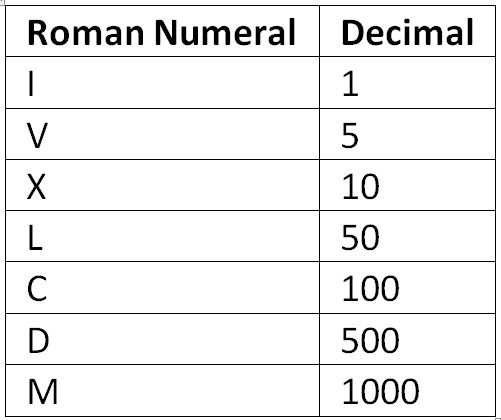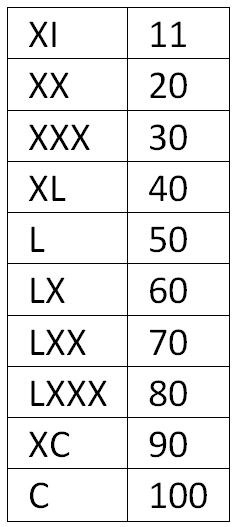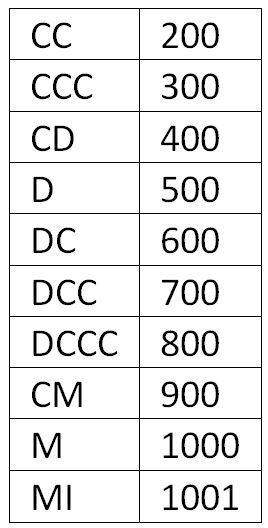Roman Numerals are the numeral system which is originated in ancient Rome. It is a decimal or base 10 number system. It is an additive or subtractive system in which letters are used to denote some base numbers and arbitrary numbers in the number system and denoted using a different combination of symbols. Here, students can check the Roman Numerals Chart, how to convert roman numerals to numbers, and solved examples in the following sections.
Roman Numerals List
Here provided are some basic roman numerals.

Roman Numerals Chart:
Roman numerals Chart has particular roman numbers for the decimal numbers from 1 to 1000.



Rules for formation of Numbers
We have three different rules to form the roman numerals as numbers. They are multiplication rule, addition rule, and subtraction rule.
Multiplication Rule:
When a roman symbol is repeated in sequence, then we have to multiply the value of the numeral by the number of times it is repeated. A symbol cannot be repeated more than three times in series.
Example:
II = 1 x 2 = 2
XX = 10 x 2 = 20
III = 1 x 3 = 3
We cannot express 4 as IIII. Because the symbol cannot be repeated more than three times.
Addition Rule:
If a smaller number is located to the right of a larger number, then you need to add numbers.
Example:
VII = 5 + 1 + 1 = 7
VIII = 5 + 1 + 1 + 1 = 8
XXII = 10 + 10 + 1 + 1 = 22
Subtraction Rule:
Writing a smaller number to the left side of a larger number means that the smaller number has to be subtracted from the larger number. The symbol I can be subtracted from V and X and X can be subtracted from L and C.
Example:
IV = 5 – 1 = 4
IL = 50 – 1 = 49
We do not repeat V twice to get 10. We already have a symbol for 10. So VV for writing 10 is not correct.
We do not subtract 5 from any symbol. VX is not correct.
Roman Numerals Questions with Solutions
Example 1:
Write the Roman Numerals for 57.
Solution:
The given decimal number is 57
Break up the number into Tens and Ones.
57 = 50 + 7
The symbol for 50 is L
7 = 5 + 2 = 5 + 1 + 1
The symbol for 7 is VII.
57 convert roman numerals as LVII.
Example 2:
Write the number for XXIV.
Solution:
Given roman numeral is XXIV
V = 5
IV = 5 – 1 = 4
X = 10
XX = 10 + 10 = 20
Therefore, XXIV = 20 + 4
XXIV = 24.
Example 3:
Write the Roman Numerals for 18.
Solution:
The given decimal number is 18.
Break up the number into Tens and Ones.
18 = 10 + 8
The symbol for 10 is X.
8 = 5 + 1 + 1 + 1
The symbol for 5 is V, 1 is I
So, the symbol for 8 is VIII
18 convert roman numerals as XVIII.
Example 4:
Write the number for XXXIX.
Solution:
Given roman numeral is XXXIX
X = 10
IX = 10 – 1 = 9
XXX = 10 x 3 = 30
Therefore, XXXIX = 30 + 9 = 39
FAQs on Roman Numerals
1. How do you write roman numerals?
Roman numerals can be written by using seven different alphabets. They are I for 1, V for 5, X for 10, L for 50, C for 100, D for 500, M for 1000. By using these symbols, you can write all roman numerals easily.
2. How to evaluate 550 in roman numerals?
550 = 500 + 50
500 = D, 50 = L
Therefore, 550 = DL.
3. What is the use of roman numerals?
Roman numerals can be used for labeling the name or position of a person or an object. Examples are Kiran came IInd in the class. Prince Charles III, Schools have Classes from VIth to Xth.
4. Write roman numerals from 1 to 10?
The roman numerals from 1 to 10 are I, II, III, IV, V, VI, VII, VIII, IX, and X.
